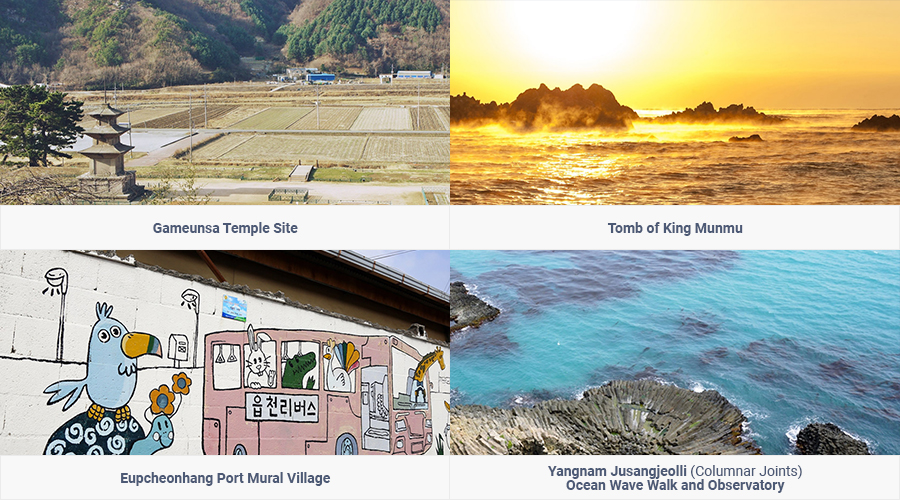
찬란한 문화유산의 보고 경주에 오신 것을 환영합니다.
992년간 신라의 서울이었던 ‘천년수도‘ 경주. 예로부터 ‘서라벌’이라고 불려온 경주의 역사는 곧 천년왕국 신라의 역사였습니다.
불교와 과학, 신라인의 예술성이 꽃피운 가장 찬란했던 고대문화와 삼국통일의 위업을 가능케 해준 화로도의 높은 기상 이 모든 것들이 생생하게 살아 숨 쉬는 역사와 문화의 고장 경주는 인류가 함께 보존해야 할 유네스코 지정 세계문화유산의 도시입니다.
천 년을 흐르는 신라의 숨결 여기는 ‘지붕 없는 박물관’ 경주입니다.
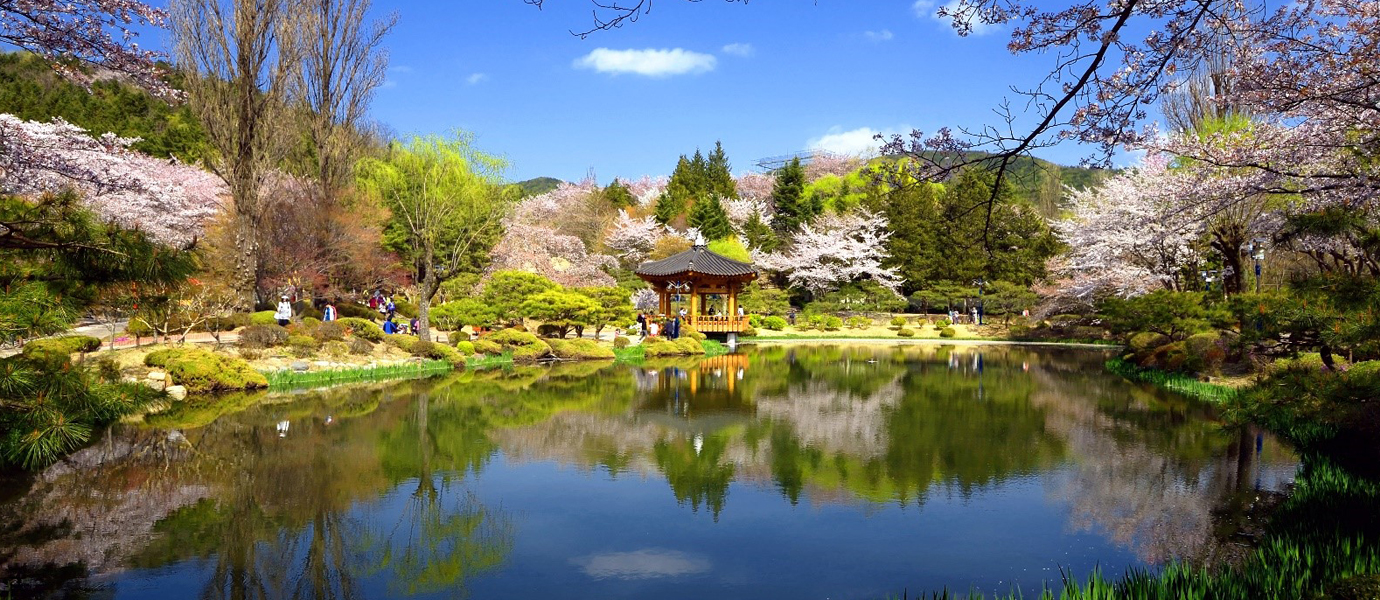
천 년 전의 핫-플레이스(Hot Place)는 오늘에 이르러서도 여전하게 핫(Hot)하다. 경주 시내권 여행의 핵심 중의 핵심코스가 있는 경주역사유적지구에 대한 수식이다.
신라의 궁성이 있던 월성을 중심으로 왕자들이 기거했던 동궁과 월지, 왕과 귀족들이 잠들어 있는 대릉원, 동양 최고(最古)의 천문대인 첨성대, 천년의 숲 계림이 모여 있는 곳.
신라의 정치와 경제와 생활, 문화가 이곳을 중심으로 번영과 쇠락을 오갔으리라. 천년 신라의 옛 모습을 상상하며 거닐고, 쉬며, 즐기는 여행. 꼭 해야 할 경주 여행 1번 타자다.
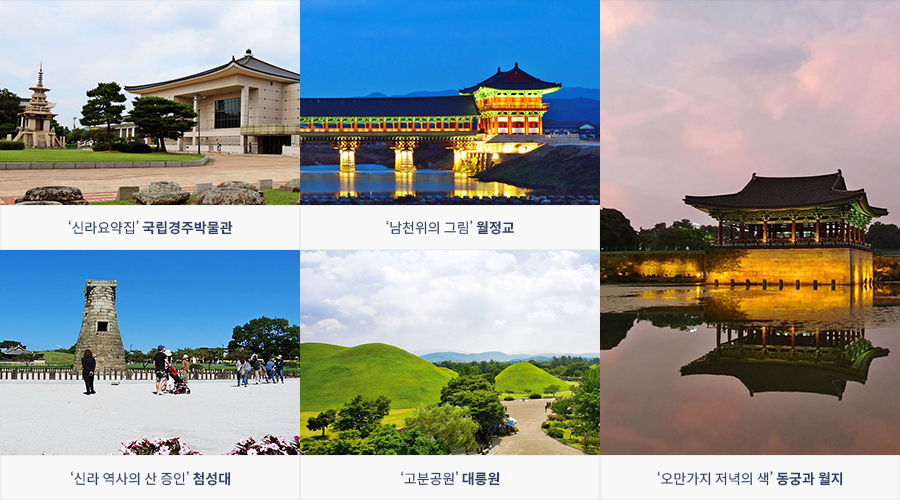
보문관광단지의 랜드마크 중 하나인 물레방아 광장 앞에 ‘대한민국 관광의 역사, 이곳에서 시작되다.’라는 기념비가 있다. 그렇다. 경주 보문관광단지는 우리나라 관광의 시작을 알리는 신호탄이었다. 먹고 사는 문제가 중요했던 그 시절을 넘어 문화와 여가에 눈을 돌리게 된 출발점. 1970년대 ‘관광’에 주목하면서 경주종합개발계획사업이 수립된 이래, 북군동, 신평동, 천군동을 아우르는 240만여 평의 면적에 종합 관광휴양지 ‘보문관광단지’가 조성되었다. 거대 인공호수인 보문호를 중심으로 그 둘레를 따라 특급호텔, 콘도, 레저 및 휴양시설, 테마 관광시설이 속속 들어섰다. 또, 보문관광단지의 대부분의 가로수는 벚나무로 식재되어 있어 봄이면 만개한 벚꽃 흩날리는 진풍경을 감상할 수 있다. 보문관광단지를 빼놓고 경주 관광을 논할 수 없을 정도로 이곳은 경주의 사계절 필수 여행코스로 손꼽힌다. 휴양과 액티비티 등 남녀노소 모두 만족할 수 있는 전천후 보문관광단지 여행을 추천한다.
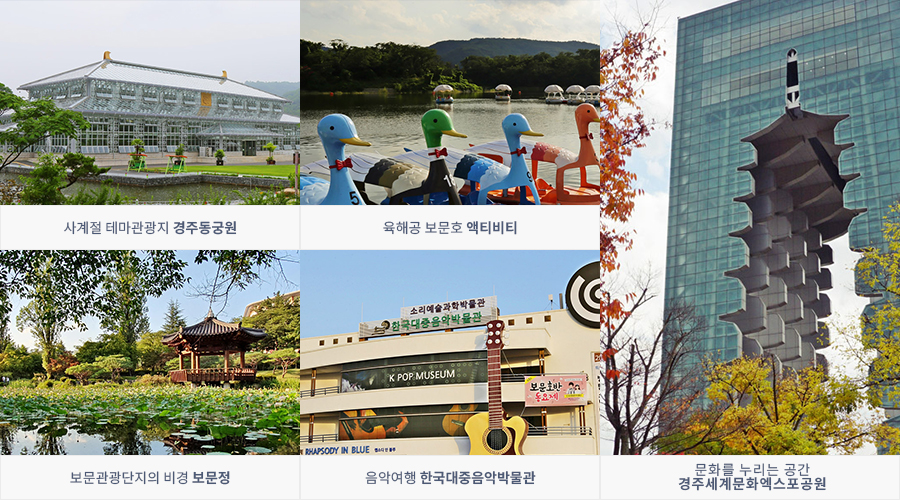
언어가 달라도 생활권이 달라도 이집트의 피라미드에서, 캄보디아의 앙코르와트에서, 한국의 불국사와 석굴암에서 우리 모두는 벅찬 감동을 느낀다. 유네스코는 이러한 인류 보편의 가치를 지닌 자연유산과 문화유산을 발굴, 보호하고자 1972년 세계문화 및 자연유산 보호협약 채택해 전 세계의 가치 있는 인류 유산을 찾아 나서고 있다.
유네스코 세계유산은 크게 세계유산과 기록유산, 무형유산으로 나뉘며, 세계유산은 다시 문화유산과 자연유산, 복합유산으로 구분된다. 이 중 문화유산이 우리가 익히 알고 있는 유네스코 세계문화유산이다. 우리나라에는 14개의 세계문화유산이 있는데, 경주는 우리나라에서 가장 많은 세계문화유산을 보유한 도시이다.
불국사와 석굴암(1995년 등재), 경주역사유적지구(2000년 등재), 한국의 역사마을 양동마을(2010년 등재), 마지막으로 가장 최근인 2019년 유네스코에 등재된 한국의 서원 9곳 중 경주의 옥산서원이 포함되었다. 경주의 유네스코 세계문화유산을 따라가며 여행해보자.
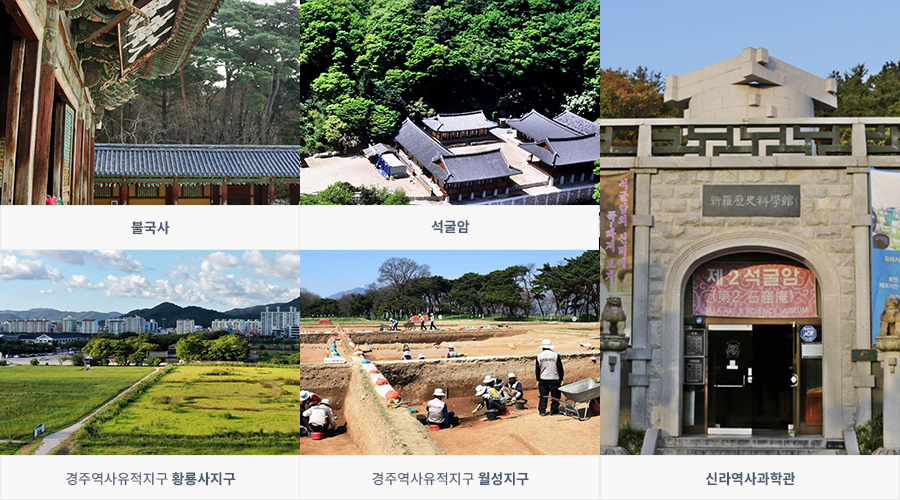
삼국시대부터 통일신라까지 천 년의 역사를 품은 경주. 경주의 역사는 곧 신라의 역사이고 신라는 곧 경주다. 그 뿌리 위에 새로운 천년의 역사가 새겨졌다.
신라의 서라벌로부터 고려의 동경을 이어 조선의 경주까지. 지명이 바뀌듯 제각각 다른 모습, 다른 문화로 존재했지만 오늘 우리에게는 모두가 어우러진 하나의 경주로 자리하고 있다. 신라의 궁성이었던 월성 안에 조선시대의 유적 석빙고가 있듯이, 신라시대 국립대학이었던 국학이 있던 자리에 조선시대의 교육기관 향교가 자리하고 있듯이 말이다. 신라 이후의 천년 경주를 찾아 떠나는 시간, 조선시대의 경주로 시간여행을 나서 본다.
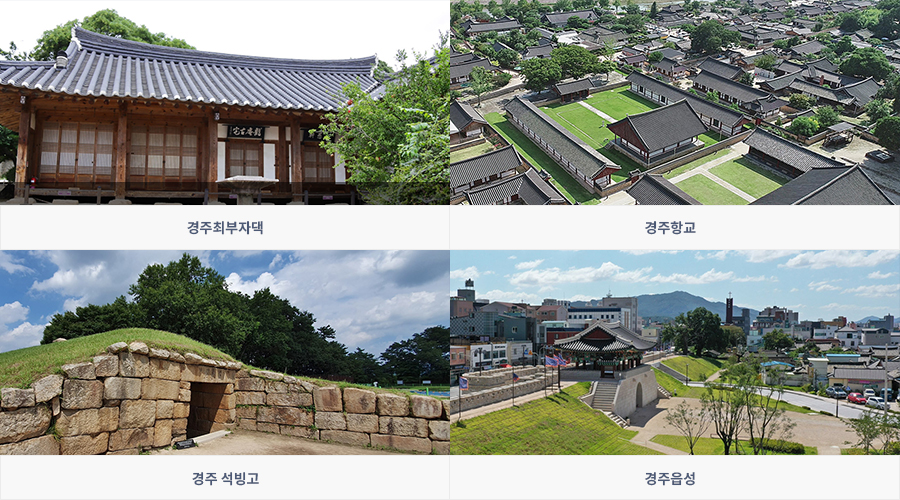
저 멀리 수평선으로부터 불어오는 바닷바람이 가라면 가라는 대로, 발길을 이끈다. 해안가에서 철썩이는 파도소리가 마음을 이끈다. 경주 시가지에서 벗어나 동해안으로 간다. 볼 것 즐길 것 천지인 경주이지만, 바닷가에서만큼은 유유자적 호흡이 긴 여행을 해보자. 물론 놓칠 수 없는 문화유산, 지질명소들이 즐비하니 볼 것은 보고 쉴 땐 쉬자는 취지다. 감은사와 문무대왕릉에서 공부하고, 자연이 빚어낸 주상절리 감상하고, 바다와 육지의 경계가 모호해지는 풀빌라에서 느긋한 휴양을 즐긴다.
경주 바다 여행 A to Z, 관광과 휴양 두 마리 토끼 잡으러 출발!
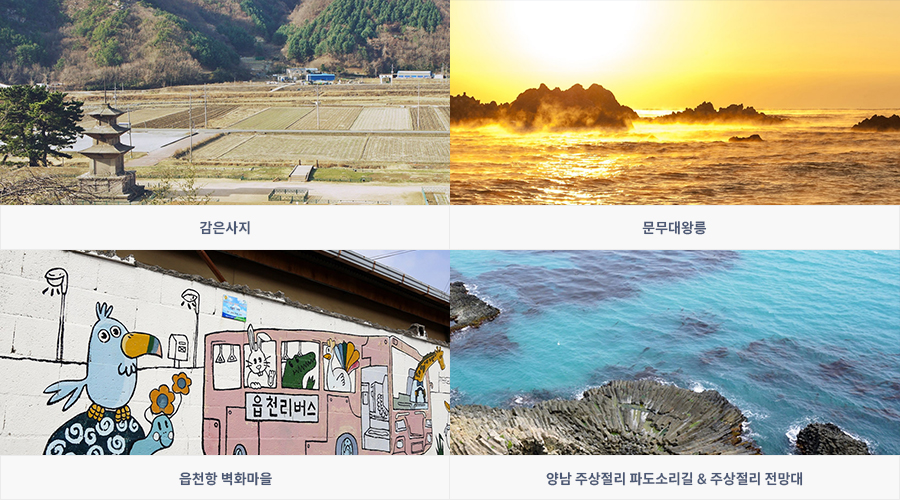
The treasure of a brilliant cultural heritage Welcome to Gyeongju.
Gyeonju was the capital city of Silla of 992 years. The history of Gyeongju, which was once called Seorabeal, is also the history of the thousand-year-old Silla Dynasty. Gyeongju embraces a radiant ancient culture where Buddhism, science, and the arts and crafts of the people of Silla flourished, and the great spirits of Hwarangdo attained the unification of the three kingdoms.
This is why Gyeongju is so well preserved by its people and thus, has been designated as a World Cultural Heritage by UNESCO. The evergreen spirit of Silla has been alive here for nearly a thousand years. Gyeongju is truly a museum without walls.

It comes as no surprise that the hot place from a 1,000 years ago remains a hot place to this day.
The key to any tour of downtown Gyeongju comes down to Gyeongju’s Historic sites.
Here, you can explore Wolseong, which served as the royal palace of Silla, Donggung and Wolji, which served as the main living quarters for princes, Daereungwon, a spot for the leisure and recreation of kings, Cheomseongdae, the oldest astronomical observatory in Asia, and Gyelim, Silla’s sacred forest.
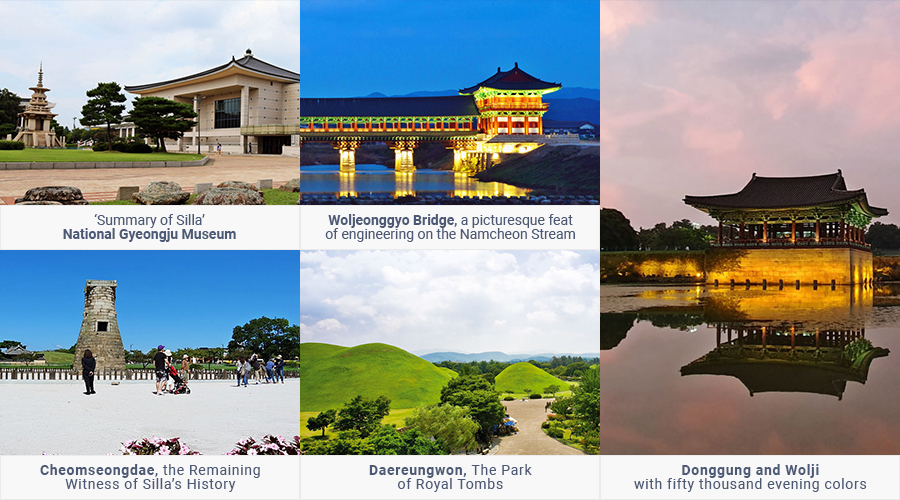
In front of one of Bomun Tourist Complex’s landmarks, the Watermill Square, stands a plaque that says, “The History of Tourism in Korea Begins Here.”
The Gyeongju Bomun Tourist Complex ushered in a new era of tourism in Korea. During a time when merely being able to eat and live under a roof were import, the Complex inspired Koreans to look beyond their daily struggles, and aspire for a life filled with culture and leisure. The Gyeongju Comprehensive Development Plan, which was established in the 1970s, directed heavy attention to tourism. As a result, the Bomun Tourist Complex was built across 793 hectares of land stretching from Bukgun-dong, Sinpyeong-dong, and to Cheongun-dong. Along the shores of a giant man-made lake (Bomun Lake), luxury hotels, condominiums, leisure and recreational facilities, and other special tourist facilities were built to attract tourists from across the country.
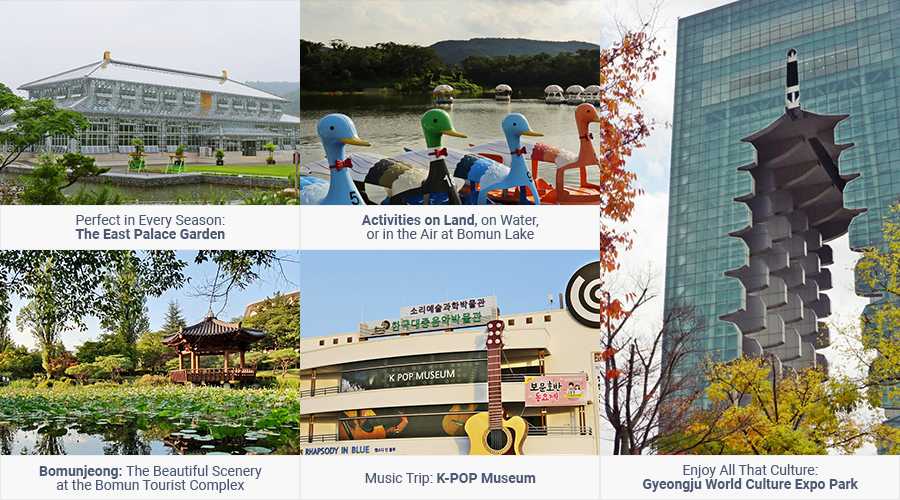
Even though we speak different languages and have different ways of living, we are all impressed by the pyramids of Egypt, Angkor Wat in Cambodia, Bulguksa Temple and Seokguram in Korea. UNESCO adopted the Convention for the Protection of World Culture and Natural Heritage in 1972 to discover and protect valuable natural and cultural heritage.
UNESCO World Heritage Sites are largely divided into separate categories such as World Heritage Sites, Recorded Heritage Sites, and Mixed Heritage Sites.
The World Heritage Sites are further divided into Cultural Heritage Sites, Natural Heritage Sites, and Complex Heritage Sites. Among these, cultural heritage refers to a UNESCO World Heritage Site that we are familiar with. There are 14 World Heritage Sites in Korea. Gyeongju is the city with the most World Heritage Sites in Korea.
Bulguksa Temple and Seokguram Grotto (listed in 1995), Gyeongju Historic Area (listed in 2000), Yangdong historical Village (listed in 2010), and most recently of the nine Confucian Academies listed in UNESCO in 2019, the Oksanseowon Confucian Academy in Gyeongju was included. Travel to see all of the UNESCO World Heritage Sites in Gyeongju!
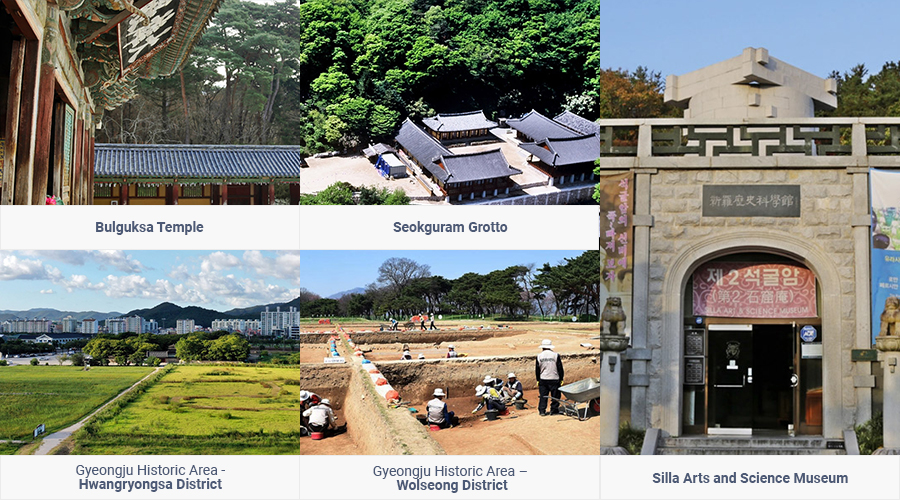
From the Three Kingdoms period to the Unified Silla period, Gyeongju served as the glorious capital city of a powerful kingdom for a thousand years. That’s why Gyeongju and Silla are synonymous when it comes to their respective history. Since the fall of Silla, however, Gyeongju spent another millennia building its own history. Seorabeol of Silla became Donggyeong of Goryeo, and then Gyeongju of Joseon. Throughout its different iterations, Gyeongju developed a unique culture. But today, Gyeongju stands as a melting pot of all three cultures.
Wolseong Palace (royal palace) built during the Silla Dynasty became the Stone Ice Storage built during the Joseon Dynasty, and the site where Gukhak (national university) of Silla used to stand became the site of one of the best known Hyanggyo (academies) institutes during the Joseon Dynasty. It’s time to take a closer look at how Gyeongju evolved over the course of a millennia after Silla. Let’s take a trip to Gyeongju during the Joseon Dynasty.
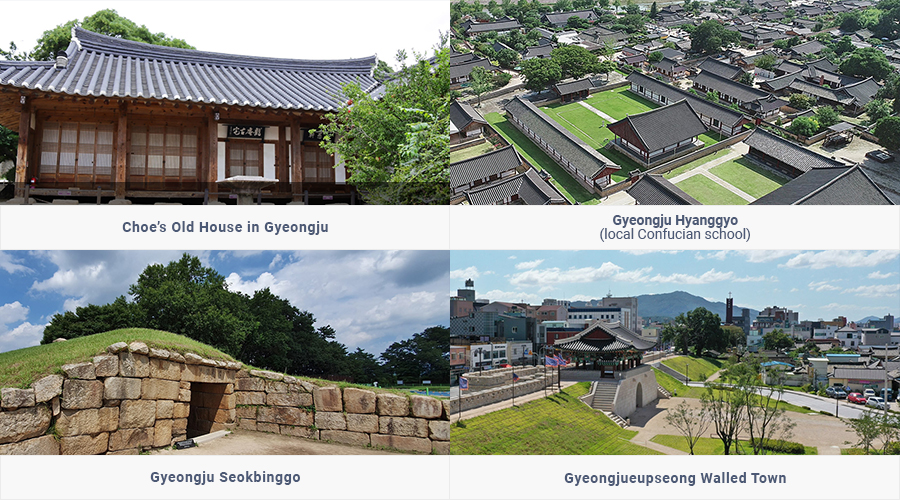
Even when you’re in downtown Gyeongju, you’ll notice the warm and inviting sea breeze blowing in from beaches near Gyeongju beckoning you towards the sea. You might start imagining the sound of ocean waves drawing you closer. If you’re longing for the sea, it’s time to leave the hustle and bustle of Gyeongju behind for a trip to the beautiful seaside.
Gyeongju may have many things to see but its coastline provides a carefree breath of fresh air. Of course, there are many cultural heritage sites and geological attractions to enjoy while you here as well. But the sea just feels particularly special. Learn about Gameunsa Temple Site and the Tomb of King Munmu, appreciate the natural beauty of Jusangjeolli or sit back and relax at a pool villa nestled in a cozy spot where the land meets the sea. This is a full guide for your trip to the sea. Enjoy your travels and relax!
